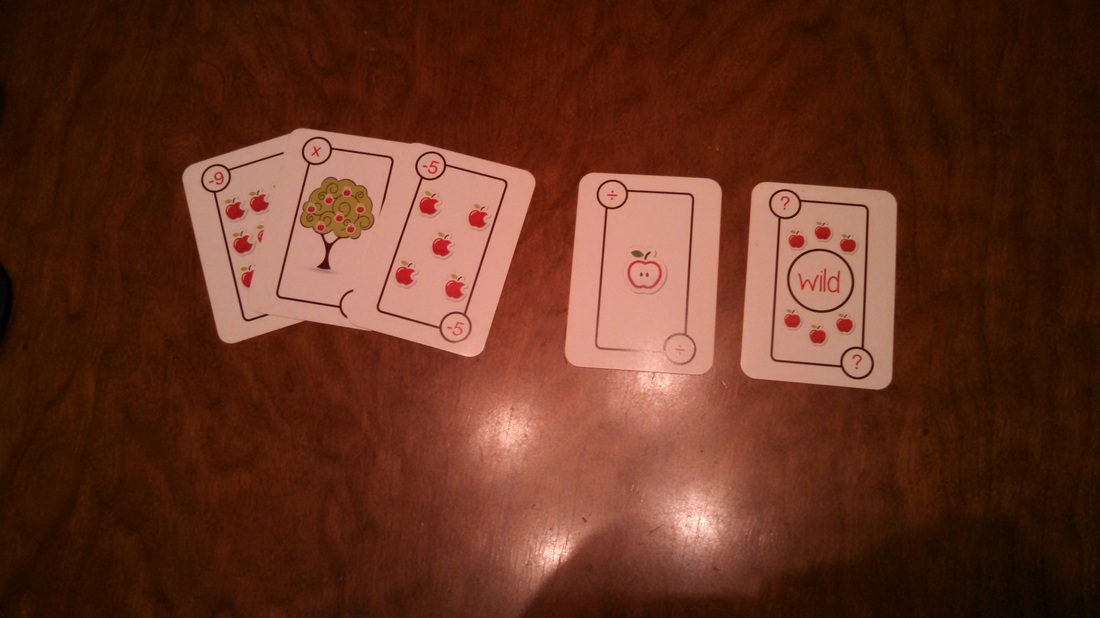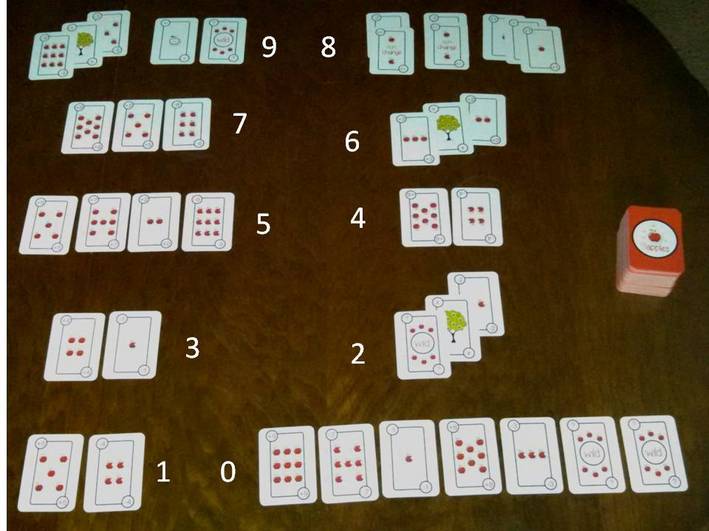Needs: 9 Apples Base Game and 9 Apples Booster Pack
Age Level: Grades 4+
Learning Objectives: Exercise knowledge of addition, subtraction, multiplication, division, and pre-algebra facts and skill; put number cards together to form equations (the more complex, the better!).
In this tutorial we will show two players playing 9 Apples using the Base Game and the Booster Pack. We will show you typical hands of cards during game play, and how those hands may be used to create equations equaling the numbers 9 and 8 (the first two numbers that each player must create equations to equal). We will also show you all of the final equations created by the player who first got to the number 0, and thus ended the game.
First hand, Player 1:
Following shuffling and dealing 7 cards to each player, the first hand of Player 1 looks like this:
Age Level: Grades 4+
Learning Objectives: Exercise knowledge of addition, subtraction, multiplication, division, and pre-algebra facts and skill; put number cards together to form equations (the more complex, the better!).
In this tutorial we will show two players playing 9 Apples using the Base Game and the Booster Pack. We will show you typical hands of cards during game play, and how those hands may be used to create equations equaling the numbers 9 and 8 (the first two numbers that each player must create equations to equal). We will also show you all of the final equations created by the player who first got to the number 0, and thus ended the game.
First hand, Player 1:
Following shuffling and dealing 7 cards to each player, the first hand of Player 1 looks like this:
As per the rules, the first equation must be equal to +9. To generate an equation with the greatest number of cards, and thus the greatest number of points, Player 1 creates the following equation:
(-9 x -5) / 5.
NOTE: While there are no parentheses cards in the deck, the player may imply their use by placing the cards in groups, which will make it clear to the other players that these functions are being performed first.
The wild card (which may take any number value 1 through 9, or -1 through -9) stands for the number 5. The remaining cards in this player's hand are a sign change card, and a multiply card.
(-9 x -5) / 5.
NOTE: While there are no parentheses cards in the deck, the player may imply their use by placing the cards in groups, which will make it clear to the other players that these functions are being performed first.
The wild card (which may take any number value 1 through 9, or -1 through -9) stands for the number 5. The remaining cards in this player's hand are a sign change card, and a multiply card.
Player 1 is unable to make another equation which equals +8, and she now chooses to discard the multiply card. Play then moves to Player 2.
The hand dealt to Player 2 looks like this:
This player's first equation must also equal 9. She uses these cards to create the following equation:
(9 / 3) + 6. The remaining cards in this player's hand are -9, -8, and -6.
(9 / 3) + 6. The remaining cards in this player's hand are -9, -8, and -6.
Player 2 is unable to make another equation which equals +8, and she now chooses to discard the -9. Play then moves to Player 1.
On her last turn, Player 1 had one card in her hand. She must now draw 6 cards to begin her turn with the required 7 cards. Below is the resulting hand:
She must now use these cards to create an equation which equals 8. She uses these cards to create the following equation: 2 + 5 + (1 / 1). She does this using a sign change card to turn the -2 card to a +2, and another sign change card to turn the -5 card to a +5. She has no cards remaining in her hand, and is therefore not required to discard.
Player 2 had two cards remaining in her hand after her previous turn; she must therefore draw 5 cards. Below is the resulting hand:
She must now use these cards to create an equation which equals 8. She uses these cards to create the following equation: 6 + 2 - 4 + 4. The remaining cards in her hand are -8, -6, and -1.
Player 2 must now choose a card to discard, and she selects -8. Play then proceeds to the left.
Play continues with each player creating equations in reverse numerical order, from 8 to 7 to 6 and so on until one player creates a final equation which equals 0. In this game Player 1 was first to create this equation. Below is a picture of each equation she used from 9 to 0.
For more information, please see the rules for 9 Apples Base Game and the rules for 9 Apples Booster Pack.
























 RSS Feed
RSS Feed
